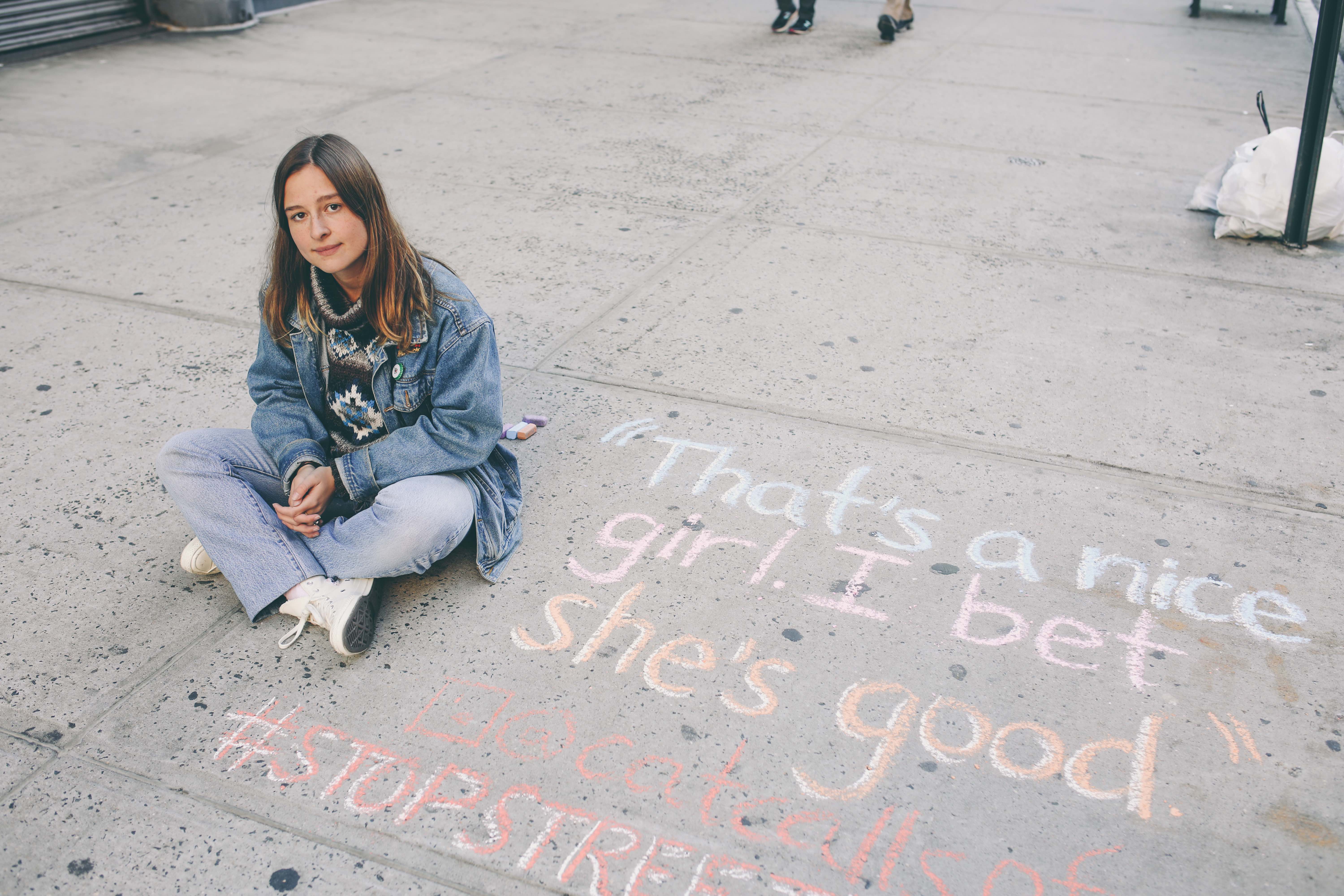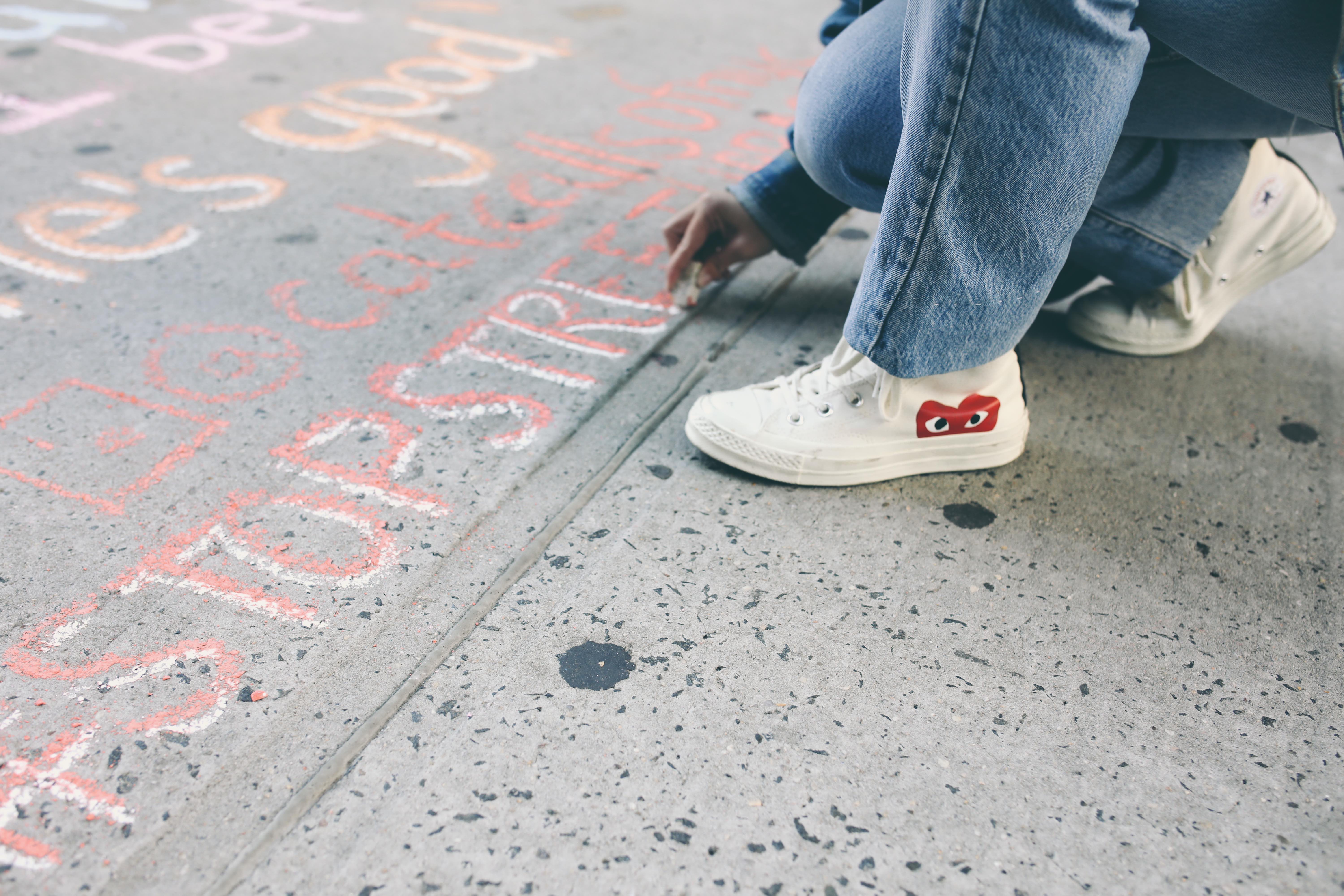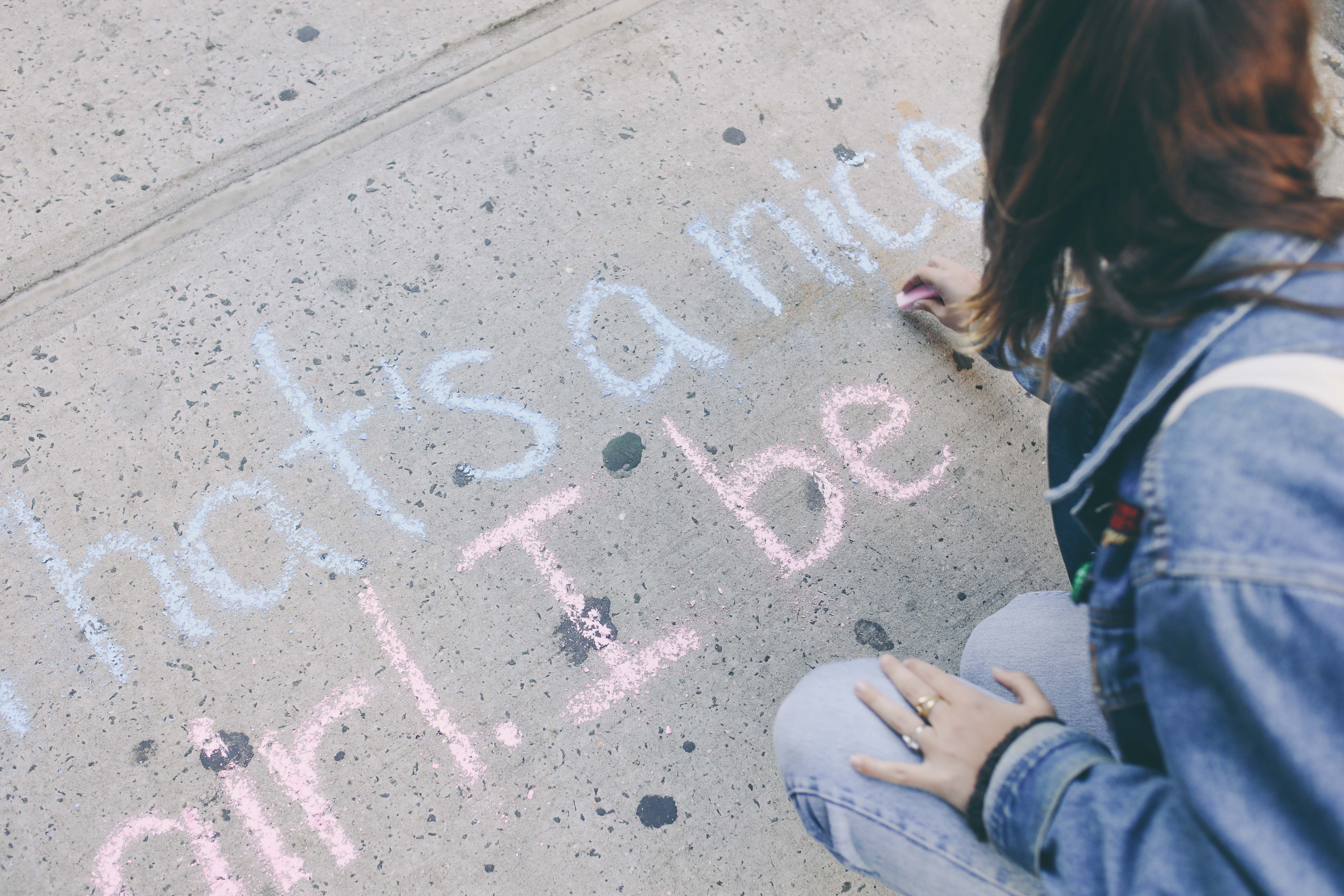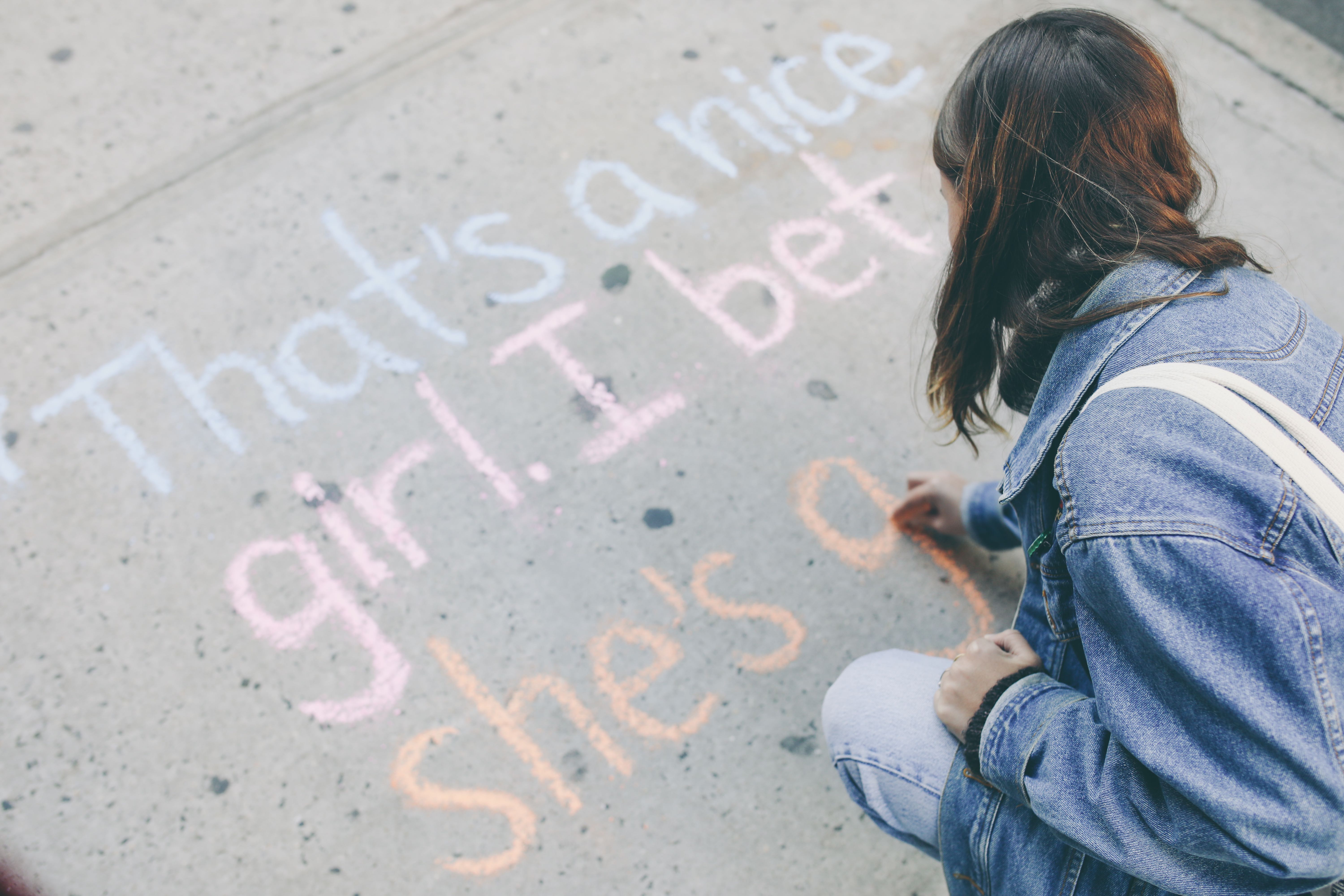While walking through Midtown Manhattan, a pedestrian might look down and see a grotesque message etched in chalk under their feet: “Hey babe. What’s under that dress?” Or a jog through Central Park might be interrupted by some vile words written in eye-catching rainbow: “Well then there’s no one to stop me from having you!”
Underneath these vile remarks is written “@catcallsofnyc” and “#stopstreetharassment.” A trip to Instagram to find the account takes you to Cat Calls of NYC, a collection of photographs of these chalked messages written on the streets of the city in the neighborhood where the catcall actually occurred.
Sophie Sandberg, the NYU student who heads the account, receives dozens of catcall submissions a day from people who feel violated, diminished and degraded. A catcall is just what the term infers — an unwelcome remark made to a woman (most often) who is being treated as nothing more than a body or an animal or a subject of the male gaze.
The messages are unsettling, disturbing and troubling, but it is this discomfort we feel when reading them that makes Cat Call’s intent so effective. It is impossible to ignore the words, written in color and bold, that have been penned verbatim directly under our feet.
While Cat Call’s messages can easily be washed away with water and some soap, the impressions the words make on the women they are directed toward are lasting and dangerous. With this account, Sandberg hopes to draw attention to an epidemic of misogyny that has permeated the streets of New York City, the United States and the world.

Cameron Andersen: Was there a specific incident that inspired this account?
Cat Calls: Growing up in New York City, I dealt with catcalling from the age of 15. My experience with it in general pushed me to start the account. My introduction to catcalling was especially troubling because it was frequent and confusing (I didn’t know about catcalling before it started happening to me). The discomfort I faced when I first started getting catcalled inspired me to start the account.
CA: Can you talk about a personal experience of yours with catcalling?
CC: My worst experience with catcalling was probably my first experience with catcalling. I was 15 and on the way to my first day of work at a summer job. I’d spent such a long time picking out my outfit and getting ready. I got out of the subway at 14th St. and had to walk to 10th Ave. I must have received about 10 catcalls just on that 15-minute walk: “Hey, beautiful,” “mmm sexy,” “good morning sweetheart,” etc.
I had no idea how to respond. At first I felt like I should say thank you. I felt so uncomfortable in my skin. I felt like there must be something wrong with me for them to be making these comments. I immediately thought my dress was too short or too low-cut. This is what frustrates me most about catcalling (and harassment in general): It often makes people think there’s something they’re doing to provoke it.
CA: What is a common reaction people have when they see you chalking these messages on the sidewalk? What was the most memorable reaction?
CC: I can’t say there’s really one common reaction. A lot of people stop and watch me while I chalk but the responses are varied. Some people ask about the project. Others claim I’m vandalizing the sidewalks. Some say I have nice handwriting. Others support me and say what I’m doing is powerful. Some people get angry and say the words aren’t harassment and that they should have the right to say whatever they want. Others will say chalk can’t change anything. Some people will thank me for what I’m doing and say they’ve heard similar catcalls before. I’d say the most memorable reaction was when a passer-by got really angry at me, approached me, called me a bitch and said I couldn’t write there.

CA: Have you found there to be there any area in NYC that has the most cat calls?
CC: They happen all over, but I’d say I probably get the most submissions in Midtown. Probably because it’s so busy.
CA: Have you ever been approached by police while writing a catcall?
CC: Never.
CA: Have there been any catcalls that you refused to write or felt uncomfortable writing?
CC: I feel uncomfortable writing many — most — of the catcalls but there are never any that I refuse to write. Some days I simply can’t bring myself to write the more vulgar ones, or I’ll ask a friend to come with me for support. Sometimes it takes me longer to get to the most vulgar ones, but I definitely plan to write all of them eventually.
CA: Are there any recurring themes with the language of the catcalls?
CC: Catcalls get very repetitive. Just looking through my spreadsheet now and searching for the word “smile” I have: “Let’s see that smile,” “Smile, lady, you’ll look prettier,” “I don’t even get a smile? Fine, honey.” “Look at that beautiful smile!” “You know that smile’s got me going crazy!” Those are just the submissions I’ve put into my running spreadsheet.
There are also a lot about specific body parts. A–: “Let me slap that a– and f— you from behind,” “Hey nice a–, baby,” “I like your a– but you’re ugly” “Look at that a–!” etc.
The same patterns go for legs and breasts. There are a lot of taunting sexually aggressive comments. Also, there are a lot of comments made toward younger girls (i.e. “Call me when you’re 18!”)
A lot of racialized comments toward women of color, many referring to black women’s skin color, like “brown skin, brown sugar” or “I like your color, chocolate.” Also many comments toward Asian women that include the word “chink” or “chinky.”
CA: Why chalk and not posters/stickers/flyers?
CC: Like catcalls, writing on the sidewalks interrupts a person while they’re walking down the street. The bright colors catch people’s attention. With chalk, I’m able to make it big and sprawl across sidewalks, but it’s also washable so I don’t get in too much trouble. The goal is really to stop people in their tracks and make them experience walking down the street in a different way. Chalk was the best method for this.

CA: Are the chalk colors you use at all aligned with that specific catcall?
CC: Honestly not usually but I do like to use red for stop street harassment because it’s like a warning color. And then for a specific catcall, “I’ll f— you harder than Trump is f—— the country,” I wrote Trump in orange as a subtle dig at his orangey skin tone. If I can think of clever ways to incorporate certain colors I do …
CA: Have you noticed that submissions of catcalls increase or decrease in response to current politics/news?
CC: Submissions definitely increase in response to current news and politics. When the #MeToo movement happened last year, that led to a lot more attention on my account, which also led to many more submissions of catcalls. Now with what’s going on in Washington, D.C., with Kavanaugh, there has been another spike in submissions, this time relating to all sorts of sexual harassment and sexual assault (not just street harassment).
CA: France has passed legislation to stop street harassment. What steps do you think the U.S. can take to cut back on catcalls?
CC: The message of my account is to promote cultural change. Through these chalk drawings and the account I engage people in conversations and raise awareness about harassment. Many people don’t know catcalling is happening because they don’t have to deal with it. By showing people the extent of the problem, I really want to encourage them to look out for others on the street and step in if they see something happening.
In order for the U.S. to really make tangible cultural change, there needs to be education about gender-based harassment taught in schools. From a young age, kids are subjected to harmful ideologies about gender, i.e. “boys will be boys,” and girls are often told to cover up to not distract boys or provoke assault. We need to stop teaching these ideologies because they continue to normalize things like street harassment, workplace harassment and sexual assault.
CA: You recently led a public chalking in Washington Square Park in New York City. Do you have any more events lined up for the future?
CC: I plan on doing another Chalk Back in Washington Square Park in the spring. The first event went really well and I’d love for the second one to attract even more people. I also hope to go to D.C. this fall around the midterm elections and chalk the sexist and harassing comments of politicians around the city and near the White House and Supreme Court.
CA: I know you’ve also started chalking #whyididntreport experiences as well as catcalls. Is there anything else you’ve thought about chalking?
CC: Like I mentioned above, I want to chalk the words of politicians around D.C. to make a political statement. Recently I also did a campaign against harassment in schools, telling stories from middle school and high school students with the #stopharassmentinschools. In the future I want to do a campaign against workplace harassment too.

CA: Do you ever feel overwhelmed by the number of catcall submissions you receive? What is something you do to combat that?
CC: I usually feel overwhelmed by the number of submissions I receive and the intimacy of the stories people tell me. I’m not a mental health professional, or qualified in anyway to council someone on their experience of sexual harassment, assault or rape (I get a range of submissions about all of these things). To combat this, I normally suggest that the people who send me submissions also talk to someone who they feel comfortable with. It’s great that they can tell me their story but it’s even better if they can share with a real human.
As for combatting feeling overwhelmed, I take my time to go through the messages. I set a certain number of messages for myself to go through each day. Sometimes it takes me a few days to respond to people, but that’s what I need to do in order to give each story enough attention.
CA: Have there been any responses from followers of your Instagram that have really stood out?
CC: There have been many positive responses that have stood out from followers on the page. A lot of women who share their story of harassment tell me that I’m the first person they’ve ever told and that it’s a huge relief to get it off their chests. I’ve also had a handful of men message me to tell me that I’ve opened their eyes to something they had no idea was so prevalent and ask me how they can be better bystanders.
CA: Have others reached out to you about starting a similar project in other parts of the country?
CC: Yes! There are over a dozen “catcallsof” accounts around the world, and they’re continuing to pop up. I have a highlight on my account with all of the worldwide accounts.
CA: Are there any self-care habits you’ve picked up? Which ones really work for you?
CC: Going on a run helps me clear my head. Also having a designated time where I don’t pick up my phone or don’t look at Instagram is super important!

















